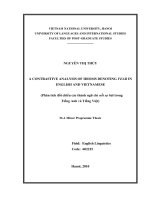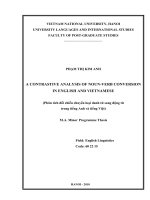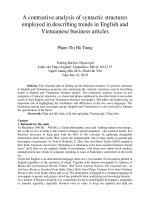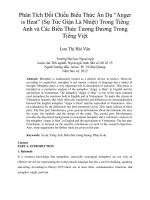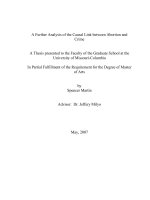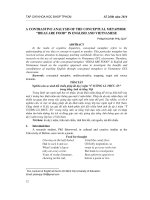A contrastive analysis of linguistic features of the adjective black in english and đen in vietnamese
Bạn đang xem bản rút gọn của tài liệu. Xem và tải ngay bản đầy đủ của tài liệu tại đây (106.63 KB, 13 trang )
1
2
MINISTRY OF EDUCATION AND TRAINING
UNIVERSITY OF DANANG
The thesis has been completed at the College of Foreign Languages,
University of Danang.
Supervisor: Assoc.Prof. Dr TR N VĂN PHƯ C
PHAN TH L HUY N
Examiner 1: Ph.D. H Th Ki u Oanh
Examiner 2: Ph.D. Lê Ph m Hoài Hương
A CONTRASTIVE ANALYSIS OF LINGUISTIC FEATURES
OF THE ADJECTIVE “BLACK” IN ENGLISH
AND “ĐEN” IN VIETNAMESE
The thesis will be orally defended at The Examining Committee.
Field: The English Language
Code: 60.22.15
Time: 15.30 April 27th, 2011. Venue: University of Danang
MASTER THESIS ON THE ENGLISH LANGUAGE
(A Summary)
The thesis is accessible for the purpose of reference at:
- The Library of College of Foreign Languages, University of Danang
Danang - 2011
- Information Resource Center, University of Danang
3
4
CHAPTER 1
INTRODUCTION
learners will be able to improve their understanding of the field, and
get the final goal – communication in an effective way.
1.1 RATIONALE
Color is considered a very important part that nature has
provided us to feed both our body and spirit. Besides, the colour
nourishes our whole living style, supplying a source of energy that is
an essential and wonderful part of life. As highly colorful beings, our
forms are made up of ever- changing color and we respond to our
color actively or passively in all that we do. In addition, the coloured
rays not only affect our physical bodies but also our emotions, mood
or mental faculties.
In fact, Black and Đen are associated with negative meanings:
ideas of death, mourning, sorrow, depress and evil, harm or
sometimes it concerns to social factors: “black-thought” (tư tư ng
ñen t i),“black-market”(ch ñen), “black-Friday”(ngày h giá)…
Theoretically, many relevant studies on Black in English and
Đen in Vietnamese have been done so far. However, researches on
linguistic features of and Đen to find out their similarities and
differences between two languages have not been carried out.
Therefore, it is necessary to do a research on this matter to enrich
characteristics of Black and Đen. As a result, the topic “A
1.3. AIMS AND OBJECTIVES OF THE STUDY
1.3.1 Aims
The study is hoped to :
- Help teachers and learners understand the semantic
diversity and usage of the adjective Black in English and Đen in
Vietnamese.
- Help teachers and learners explore similarities and
differences of cultural characteristics of each country implied through
its language.
Contrastive Analysis of Linguistic Features of the Adjective
“Black” in English and “Đen” in Vietnamese has been carried out
according to the reasons above.
1.2. JUSTIFICATION FOR THE STUDY
With the contrastive analysis of the different features of
meaning of the adjective Black and Đen, pragmatic acquisition of
how to apply such an adjective in appropriate and suitable ways,
1.3.2 Objectives
The study is planned to :
- Make a contrastive analysis of semantic and pragmatic
features of the adjective Black in English and Đen in
Vietnamese
- Find out similarities and differences of semantic and
pragmatic features of the adjective Black in English and Đen
in Vietnamese.
1.4. RESEARCH QUESTIONS
The paper will find the answers to the following questions:
(1) What are the semantic features of the adjective Black in
English and Đen in Vietnamese?
(2) What are the semantic similarities and differences of the
adjective Black in English and Đen in Vietnamese?
(3) What are the pragmatic features of the adjective Black in
English and Đen in Vietnamese?
(4) What are the pragmatic similarities and differences of the
adjective Black in English and Đen in Vietnamese?
5
6
1.5. SCOPE OF THE STUDY
This study is restricted to describe, analyse and contrast the
semantic and pragmatic features of the adjective Black in English and
Đen in Vietnamese in compound words, collocation and idiomatic
phrases. The contrastive analysis is based on the source language of
English in contrast to Vietnamese. The study is carried out with the
essential sources on 300 adjectives Black, 300 adjectives Đen and
300 samples selected from British, American and Vietnamese
stories, novels, and idioms books. Also, some educational, political,
economic and health newspapers and magazines are added to.
CHAPTER 2
LITERATURE REVIEW AND THEORETICAL
BACKGROUND
1.6. ORGANIZATION OF THE STUDY
Chapter 1 – “The Introduction”
Chapter 2 – “Literature Review and Theoretical Background”
Chapter 3 – “Method and Procedure”
Chapter 4 – “Findings and Discussions”
Chapter 5 – “The Conclusion”
2. 1. LITERATURE REVIEW
It is necessary to pay attention to the study of words denoting
color which has joint effect on semantic recognition of adjectives,
especially the adjective of color. In the study by Truong Thanh Ngoc
(2003), [52,p.33-60], what attracts the reader is detailed mention of
semantic facets of such colors as black, white, green, red, yellow,
blue, brown, grey, orange, pink and purple. However, in other study
by Mai Nguyen Dieu Khoa (2005), [30,35-36], it does go far in this
semantic level. She focuses her attention on the study of metaphoric
meaning of such kind of adjective which includes six main colors.
Taking notice of diverse and symbolized significance similarly, in
her study (2005), Nguyen Thi Dieu Hao [38,p.23-60] finds that
people often tend to use Idioms denoting color words in daily
communication.
In fact, many authors make great use of adjectival
characteristics in the hope of bringing about its semantic and
pragmatic recognition profoundly. Pustejovsky’s [40] demonstration
of typical ambiguity and context dependence of adjective like fast
where the adjectival interpretation varies depending on noun being
modified is remarkable.
2.2. THEORETICAL BACKGROUND
2.2.1. Definition of Color
Color is the visual perceptual property corresponding in
humans to the categories called red, green, blue and others. Color
categories and physical specifications of color are also associated
with objects, materials, light sources, etc., based on their physical
7
8
properties such as light absorption, reflection, or emission spectra. By
defining a color space, colors can be identified numerically by their
coordinates.
2.2.4.3. Derivation Words: are ones containing affixes as
derivatives: blackish, exhausted, peaceful…
2.2.4.4. Compound Words: are units consisting of two or
more bases, in some cases, they are composite words: blackbird,
blackboard, White House…
2.2.4.5. Reduplicational Words: Some compounds have two
or more elements which are either identical or only slightly different.
For example, good – goody means affectedly well.
2.2.2. Basis Color Terms
According to Brent Berlin and Paul Kay, in a classic study
(1969) of worldwide color naming, argued that these differences can
be organized into a coherent hierarchy, and that there are a limited
number of universal "basic color terms" which begin to be used by
individual cultures in a relatively fixed order. Berlin and Kay based
their analysis on a comparison of color words in 20 languages from
around the world. To be considered a basic color term, the words had
to be monolexemic ("green", but not "light green" or "forest green"),
high-frequency and agreed upon by speakers of that language.
2.2.3. Words Denoting Colors (WsDC)
Color words are freely used to describe different things, such
as features of the characters faces, clothes, jewellery, make-up, cars,
landscapes and seascape, pieces of art etc. In fact, English has a self
contained set of 11 words that can be described as “basic colour
words” black, white, red, yellow, green, blue, brown, pink, orange,
purple and gray (ñen, tr ng, ñ , vàng, xanh lá cây, xanh lơ, nâu,
h ng, cam, tía và xám).We normally mention WsDC as natural
characters or in denotative meaning. However, WsDC are also used
to express different ideas, thoughts, feelings, attitude in connotative
and social meaning in daily communication.
2.2.4. Types of Word
2.2.4.1. Simple Words: are largely monosyllabic. For
example: go, white…
2.2.4.2. Complex Words: contain one or more bound
morphemes and one free morpheme: country, study…
2.2.5. Approaches to Collocations
This paper deals with the definition by Watson [42, p.7]:
“collocation is the placing together of words which are often
associated with each other, so that they form common patterns or
combinations”.
2.2.6. Idioms
An idiom is an expression, word, or phrase that has a
figurative meaning that is comprehended in regard to a common use
of that expression that is separate from the literal meaning or
definition of the words of which it is made.
However, with limitation of data, in this paper we just
consider idiomatic phrases denoting the adjective Black and Đen
2.2.7. Semantic Features
Semantic features play a very important part in
differentiating the match between word and meaning. We need a very
large number of features to do this work. But linguists believe that a
much smaller number of features would be needed in writing
grammar description.
9
2.2.7.1. Components of Word Meaning
a. Denotation is a part of the meaning of a word or phrase that
relates it to phenomena in the real world or in a fictional or possible
world.
b. Connotation is the additional meanings that a word or phrase has
beyond its central meaning. These meanings show people’s emotions
and attitudes towards what the word or phrase refers to.
2.2.7.2. Transference of Meaning
a. Metaphor
According to Arnold (1986), a metaphor is a transfer of name
based on the association of identical features and this is actually a
hidden comparison.
b. Metonymy
According to Arnold, metonymy can be defined a transfer
based on the aasociation of contiguity. In fact, it is a transfer of
names between things which are known to be in some ways or others
connected in reality or the substituation of the name of an attribute of
a thing for the name of the thing itself.
c. Polysemy
Polysemy which is characteristic of most words in English is
property of a single word, so we should talk something about
polysemy. It is a semantic phenomenon in which a word has two or
more similar meanings.
2.2.7.3. Semantic Fields
The semantic structure of vocabulary of a language can be
studied in a precise and systematic way by means of componential
analysis of which the theory of semantic field greatly leans.
10
2.2.8. Pragmatic Features
Pragmatics is a subfield of linguistics which studies the
ways in which context contributes to meaning. Pragmatics
encompasses speech act theory, conversational implicature, talk
in interaction and other approaches to language behavior in
philosophy, sociology, and linguistics.
2.2.9. Culture in Language
It is considered that features of our lifestyle are our use of
things in the world around us to extend the capabilities, the complex
social structure and so forth. In fact, language has become the vital
means whereby we can carry out our social lives: language for
learning, language for planning, language for co-operation. Speakers
and writers, within the context of culture, use language in many more
specific situations.
2.2.10. Excel Statistics
We used Excel to do some basic data analysis tasks because it is a
reasonable alternative to using a statistical package for the same
tasks.
11
12
CHAPTER 3
METHODOLOGY AND PROCEDURES
- Examining the pragmatic features of the adjectives Black
and Đen
- Giving contrastive analysis of Black and Đen in terms of
pragmatic features.
- Drawing conclusions on semantics, pragmatic of the
adjectives Black and Đen
- Putting forwards some implications for teaching, learning
and translating work and further researches.
- Closing the study with References and Appendixes
3.1 RESEARCH DESIGN AND METHODOLOGY
With the purpose of making a description and contrastive
analysis of linguistic features between the adjective Black in English
and Đen in Vietnamese, this study is intended to follow qualitative
approach and develops in different chapters containing some basic
theoretical concepts related to semantic and pragmatic features of the
adjective Black in English and Đen in Vietnamese.
3.2. RESEARCH PROCEDURES
Many steps are employed to carry out this paper including
data collection, data sorting and finally data analysis, however, the
following two phrases will be specifically mentioned as follows:
3.2.1. Data Collection
I choose 300 adjectives Black and 300 adjectives Đen in
different collocations randomly to be samples of the thesis. The study
is also carried out with the essential sources from British, American
and Vietnamese stories, novels and several educational, political,
economic and health newspapers and magazines.
3.3.2. Data Analysis
- Collecting samples of the adjectives Black and Đen from
the Websites and some dictionaries (English – English, English –
Vietnamese, Vietnamese – English, and Vietnamese- Vietnamese).
- Classifying the meaning of the adjectives Black and Đen
according to their categories of semantic features
- Describing the semantic features of the adjectives Black and
Đen
- Giving contrastive analysis of Black and Đen in terms of
frequency and semantic features.
3.3. RELIABILITY AND VALIDITY
Analysing and contrasting semantic and pragmatic of the
adjective Black in English and Đen in Vietnamese require collecting
corpora of literature works and some Websites to be studied. Since
the whole research work relied on the Websites, it was all-important
that these works should be carefully read and that examples should
be cautiously selected in order to ensure a satisfying reliability of
results.
13
14
CHAPTER 4
DISCUSSION OF FINDINGS
CONTRASTIVE ANALYSIS OF LINGUISTIC
FEATURES OF THE ADJECTIVE "BLACK"
IN ENGLISH AND "ĐEN" IN VIETNAMESE
k. Marked by disaster or misfortune: black areas of drought; Black
Friday.
wearing black or dark clothing or armor: the black prince.
l. Based on the grotesque, morbid, or unpleasant aspects of life: black
comedy; black humor.
m. done or written in black to indicate, as on a list, that which is
undesirable, sub-standard, potentially dangerous: black flag.
n. Illegal or underground: black economy, black market
o. Showing a profit; not showing any losses: the first black quarter in
two years.
p. deliberately false or intentionally misleading: black propaganda.
However, through collected data from British and American
novels, stories , newsapers, the adjective Black is surveyed to contain
cases of meaning as follows:
Firstly, Black denotes meaning of color defined as lacking
hue and brightness; absorbing light without reflecting any of the rays
composing it and it is used in the following phrases: black hair, black
pepper, black eyes, black coal, black box, black body, black hole, etc.
Besides, from such a black color, Black also gets transference
of meaning through two ways: metaphor and metonymy.
In fact, in the first case of metaphor, Black is used to mention
something similar to black color and based on its outward
similarities, some other things can be named such as: black face, the
black people, black bean, black culture, black skin, black English,
etc.
Moreover, in the case of metaphor two, Black also means
black color but it is understood something unobvious or characterized
by absence of light; enveloped in darkness seeked in the following
4.1 SEMANTIC FEATURES OF THE ADJECTIVE "BLACK"
IN ENGLISH AND "ĐEN" IN VIETNAMESE
4.1.1. Semantic Features of the Adjective Black in English
4.1.1.1. Semantic Structures of the Adjective Black in English
According to Oxford Collocations Dictionary, the adjective
Black denotes the following cases of meaning:
a. Lacking hue and brightness; absorbing light without reflecting any
of the rays composing it: blackboard, black pen
b. Characterized by absence of light; enveloped in darkness: black
night.
c. Pertaining or belonging to any of the various populations
characterized by dark skin pigmentation, specifically the darkskinned peoples of Africa, Oceania, and australia: black musician,
black President
d. Soiled or stained with dirt: black hands
e. Gloomy; pessimistic; dismal: black outlook.
f. Deliberately; harmful; inexcusable: black lie.
g. Boding ill; sullen or hostile; threatening: black words; black looks.
h. (of coffee or tea) without milk or cream: black coffee, black tea
i. Without any moral quality or goodness; evil; wicked: black heart,
black crimes
j. Indicating censure, disgrace, or liability to punishment: a black
mark on one's record.
15
16
phrases: black night, black hole, black body, black box, black-spot,
black mark, blackmail…
In addition, the cases of meaning of the adjective Black is
also semantically developed by metonymical transference.
4.1.1.2. Semantic Fields of the Adjective Black in English
thought/
outlook
Semantic
Fields of
Compound
Collocation
Idiomatic
Phrases
Percentage
1. Color
black coffee
black
eyelash
as black as
coal
51
(17%)
2. Complexion
black
black face
as black as
37
soot
(12,33%)
3. Animals
black bird
Black
as black as
27
swallowtail
crow
(9%)
as black as
the
25
(8,33%)
"Black"
culture
4.Plants
blackthorn
black bean
5.
black gold
black Friday
Sambucus
Business/
6. Evil
7.
23
black
Investment
be in the
(7,66%)
21
(7%)
Blackmail
Politics/
black-spot
black
humour
Blackball
black Power
Men
Military
in
20
black
black box
black - and
19
radiator
8.Technology
(6,66%)
–white
(6,33%)
black
body
9.
Physical
state
black hole
black body
go black
18
(6%)
10.
black
black mood
black
17
Ideas/
(5,66%)
feelings
11. Disease
black waterfever
black death
12.
black
black Monk
Religion/
Belief
Table 4.1: The semantic fields of the adjective Black summarized
from collected data
thought
13.
Temple
Art/
12
(4%)
the
black
sheep
black magic
black bottom
black jack
black luck
(3,66%)
10
Entertainment
14. Gambling
11
(3,33%)
a black day
9
(3%)
4.1.2. Semantic Features of the Adjective Đen in Vietnamese
4.1.2.1. Semantic Structures of the Adjective Đen in Vietnamese
According to Vietnamese - Vietnamese Dictionary - Bui
Phung (World Publisher), Đen contains some cases of meaning as
follows:
a. Shortage of hue and brightness; absorbing light without reflecting
any of the rays composing it: tóc đen, bút đen, b ng đen, xe ñen…
b. Absence of light or to be enveloped in darkness: ñêm ñen, mây
ñen, b u tr i ñen k t
c. Color of clothing: qu n ñen, v ñen, áo ñen
d. Color of technological devices: h p ñen, v t th ñen, màn hình
ñen, h ñen
d. Something illegal or underground: ch ñen, qu ñen
e. Various populations characterized by dark skin, specifically the
dark-skinned peoples around the world: th dân da ñen, châu l c ñen
f. Something gloomy; pessimistic; dismal: tương lai ñen t i
g. Without any moral quality or goodness; evil; wicked, harmful: ñen
b c, quy n l c ñen, ñi m ñen, tư tư ng ñen t i, xã h i ñen
h. Disaster or misfortuneness: cái ch t ñen, ñen ñ i, v n ñen
17
18
Nevertheless, based on collected data form Vietnamese
novels, stories and lots of newspapers and magazines, Đen is
recognized to contain the following cases of meaning:
First of all, Đen denotes meaning of black color that can be
listed in some phrases: tóc đen, chó đen (chó m c), ng a đen (ng a
ơ), đũa ñen (ñũa mun), gà ñen (gà ác), b ng ñen, áo ñen, etc.
In fact, similar to Black, Đen is also semantically transferred
through two devices of metaphor and metonymy.
công ngh
(6%)
9. Hi n tư ng
đêm t i đen
d uh c
lý tính
Table 4.2: The semantic fields of the adjective Đen summarized from
collected data
Semantic
Fields of
10. Tư tư ng/
đen đ i
tư tư ng đen
Tình c m
đen như đít
ch o
53
(17,66%)
m t đen
đen như c t
Collocation
1. Màu s c
b ng đen
2. Làn da
đen bóng
"Đen"
nhà cháy
gà ác
đen
chó m c
5. Kinh doanh
l c bình đen
vàng đen
như
S đen
đen như c
tam th t
ñ u ñen
ch ñen
26
(8,66%)
ngày th
sáu
quy n
Đ i
ñen
8. K
h p ñen
thu t
Bàng
Đ n th ñen
phim tr ng
bôi ñen
N m
m c
13
ñen
thu t
14. Bài b c/
ñ ñen
(4,33%)
12
(4%)
11
ñen
(3,66%)
v n ñen
c
b c canh
ñ canh ñen
10
(3,33%)
l c
m t s t ñen sì
(7,66%)
Table 4.3: Relative frequency of Black in English and Đen in
Vietnamese
Fields
Black
order(F) English
in
1.
Color
2.
Complexion
3.
Animals
4.
Plants
22
(7,33%)
xã h i ñen
20
(6,66%)
h ñen
4.1.3. Similarities and Differences in the Semantic Features of the
Adjective Black in English and Đen in Vietnamese
23
đen
7. Chính tr
giáo h i đen
27
(9%)
đen t i
6. T i ác
12. Tơn giáo/
Tín ngư ng
(10,66%)
(chim) cu c
4.Th c v t
gan ñen
Ngh
16
(5,33%)
11. B nh t t
32
Compound
3. Đ ng v t
ñen b c
Percentage
răng ñen
ăn
t i
Cá cư c
Idiomatic
Phrases
17
(5,66%)
13.
4.1.2.2. Semantic Fields of the Adjective Đen in Vietnamese
ñen như m c
18
Percentage
51
(17%)
37
(12,33%)
Đen
in
Percentage
Vietnamese
Màu s c
53
(17,66%)
Làn da
32
(10,66%)
27
(9%)
Đ ng v t
27
(9%)
25
(8,33%)
Th c v t
26
(8,66%)
19
5.
Business/
Investment
6.
Evil
7.
Politics/
Military
Technology
8.
9.
Physical state
23
(7,66%)
20
Kinh doanh
T i ác
22
(7,33%)
20
(6,66%)
Chính tr
20
(6,66%)
19
(6,33%)
K
thu t
cơng ngh
18
(6%)
Hi n tư ng
lý tính
17
(5,66%)
Table 4.4 Comparison between Black in English and Đen in
Vietnamese
23
(7,66%)
21
(7%)
18
(6%)
18
16
14
12
10
Black in English
8
Đen in Vietnamese
6
4
2
0
10.
Ideas/
thought/
feelings
17
(5,66%)
12
(4%)
Tư tư ng/
Tình c m
B nh t t
F1
16
(5,33%)
11.
Disease
13
(4,33%)
12.
Religion/
Belief
11
(3,66%)
Tơn giáo/
Tín ngư ng
12
(4%)
13.
Art/
Entertainment
10
(3,33%)
Ngh thu t
11
(3,66%)
14.
Gambling
9
(3%)
Bài b c/ Cá
cư c
10
(3,33%)
F2
F3
F4
F5
F6
F7
F8
F9
F10 F11 F12 F13 F14
4.1.3.1. Similarities:
a. Frequency:
The counted percentage shows that frequency of usage of
word-groups in semantic combination with the adjective Black
and Đen in most of fields is basically equivalent.
b. Semantics:
In general, the adjective Black in English and Đen in
Vietnamese contains cases of meaning such as: lacking hue and
brightness, absence of light or darkness, illegality, wick or harm,
disaster, secret.
4.1.3.2. Differences
a. Frequency
Through description, classification and contrast, we
recognize that most of the word-groups combined with Black in
English and Đen in Vietnamese used in different fields hardly get
greatly different frequency.
21
22
b. Semantics
In English, the adjective Black always stands before a
head noun to form a combinative phrase such as: “black market,
black jack, black mood”. However, this rule is contrastive to the
adjective Đen in Vietnamese. In fact, it is sometimes not necessary
for Đen to combine with or appear before a noun. Unlike Black, Đen
can combine with either a noun or an adjective to form a compound
adjective or compound noun, for example, “ñen ñ i, ñen bóng, v n
ñen, chè ñen…”
devices to show progressess, initiativeness or secrets in technology
that need to be researched continuously.
Sixthly, the English also use Black to mean something
wicked or harmful to human’s life and society that can be seen
through the phrases black hands, black heart
4.2 PRAGMATIC FEATURES OF THE ADJECTIVE
"BLACK" IN ENGLISH AND "ĐEN" IN VIETNAMESE.
4.2.1. Pragmatic Features of the Adjective Black in
English
Firstly, based on historical features, social and cultural
backgrounds, the English would like to use Black to mention
educational aspects in certain periods of society in order for people
around the world to deeply understand their culture.
Secondly, Black used by English people implies racial
discrimination with black people when they mention “black culture
or black music
Thirdly, in practice Black is also used to refer to disaster or
misfortunes in business or diseases such as : Black-Death, Black
Tuesday that can be defined correctly only by putting it in the right
context or getting into detail of searching its true information.
Fourthly, Black is used to mean something illegal, unhealthy
or unsuitable for the rules or moral values in economy or in society,
for examples black market, black budget.
Fifthly, together with the development of science and
technology, the adjective Black is also used to name technoligical
4.2.2 Pragmatic Features of the Adjective Đen in Vietnamese
Firstly, together with effects of Estern culture, social
background, and historical events, Vietnamese people tend to use
Đen to imply something dealing with their belief.
Secondly, like Black, Đen is also used to reflect educational
characteristics to explain schooling aspects in certain cultural stages.
Thirdly, in Vietnamese, Đen is applied to
mention illegal things or wrong doings to
criticize unlawful activities in some fields.
Fourthly, more distinctively, Đen in
Vietnamese is used to refer to common people
“dân ñen, dân ngu cu ñen” who are regarded as
the lower social classes in society.
Fifthly, Đen in Vietnamese also implies wick, pessimism or
lacking of moral quality that can rule or harm human’s life.
Seventhly, Vietnamese people tend to use Đen to reflect
cultural aspects like “nhu m răng ñen”- a symbol of beauty of
Vietnamese
4.2.3 Similarities and Differences of Pragmatics Features of the
Adjective Black in English and Đen in Vietnamese
4.2.3.1. Similarities:
Firstly, Black in English and Đen in Vietnamese are used to
mention educational aspects.
23
24
Secondly, both Black and Đen in two languages focus on
reflecting something illegal or irregular in society.
Thirdly, something considered wick, pessimism, or without
moral quality are also used in both languages.
Lastly, the phrases of plants “black tea, black coffee, black
bean” and “chè ñen, ñ u ñen, cà phê ñen” are used in both English
and Vietnamese and they focus on effects of human’s health.
CHAPTER 5
4.2.3.2 Differences:
The first thing is due to cultural differences between two
countries, Black in English tend to imply racial discrimination
between black people and white ones. However, this does not occur
for the case of Đen in Vietnmese.
The second thing is that when Vietnamese people mention
Đen, they often think unluck, sufferings or misfortuity such as “v n
ñen, s ñen, ñen ñ i…”.
The last thing is Đen used in Vietnamese focuses on the
lower social classes such as “dân ñen, dân ngu cu ñen” that are in
poverty and usually dominated. In contrast, the English use Black to
mention black people with an implicature of racial discrimination.
CONCLUSION AND IMPLICATION
5.1 CONCLUSION
In fact, in Chapter One, the first important thing should be
done is to mention the rationale of the study, the aims and objectives
the study towards. Morover, the research questions and scope of the
study are also added.
The Chapter Two of the study started with a review of related
previous studies, necessary theories of the topic are carefully
examined which brings a basic foundation for the data analysis as
well as the content of discussion of finding in the following chapters.
Meanwhile, in Chapter Three, it is essential to give out the
methods and procedures of the study. In addition, the source of data
as well as data analysis are also mentioned.
And in Chapter Four the findings of the research on the
semantic and pragmatic features of the adjectives Black and Đen are
presented.
Semantically, the adjectives Black and Đen are regarded as
ones with diverse meanings. Actually, in order to deeply understand
their cases of meaning, it is important to consider them in their
collocations. From such various meanings, with a desire of
discovering in what fields Black and Đen refer to, they should be
summarized in each field of color, complexion, business, plants,
animals, art, etc…
Pragmatically, based on the outward meaning of black color,
the adjectives Black and Đen focus on reflecting various aspects of
human’s life. It should be noted in the last Chapter, the paper
intends to provide some suggestions for translational equivalents in
Vietnamese and English of the adjectives Black and Đen
25
26
5.2. IMPLICATIONS ON TEACHING, LEARNING AND
features. Consequently, it is necessary to give some suggestions for
the possible translational equivalents of the adjective Black and Đen
in each separated sense. However, there are some aspects that have
not been dealt with within this framework, calling for further
investigation:
- Syntactic features and collocations of Black and Đen
- Cultural characteristics of another words denoting colors
“red, blue, yellow, white…”
TRANSLATION
5.2.1. Implications on the Language Teaching and Learning
Within the scope of this study, we have dealt with some basic
knowledge of collocation, idioms, semantic structures, semantic
fields as well as pragmatic features of the adjectives of Black and
Đen .The finding of the study may be in one way or another
beneficial to the language learners since it provides a good
background of how to use the meanings of the adjective
appropriately. For the language teaching, this study may be another
sign implicating the need of encouraging students to exploit the
diverse meanings of adjectives for the purpose of using adjectives
flexibly and sufficiently.
5.2.2. Implications on Translation Work
It can be said that any of the linguistic thesis is directed to
pedagogical implications. An investigation into semantic and
pragmatic features of the adjectives Black and Đen leads both
teachers and learners of English and Vietnamese to some shared
implications. Since there are differences in perception of the
adjective Black and Đen, translative complexity is inevitable. Laying
stress on special attention to the contextual adjective between English
and Vietnamese is an effective way to cope with what the authors
mean. And it is also the requirement for both Vietnamese and English
learners and translators who have ambition of getting a proper
translated version.
5.3. LIMITATIONS AND SUGGESTIONS FOR FURTHER
RESEARCHES
This thesis has made a study of the linguistic features of the
adjectives Black and Đen which include the semantic and pragmatic


